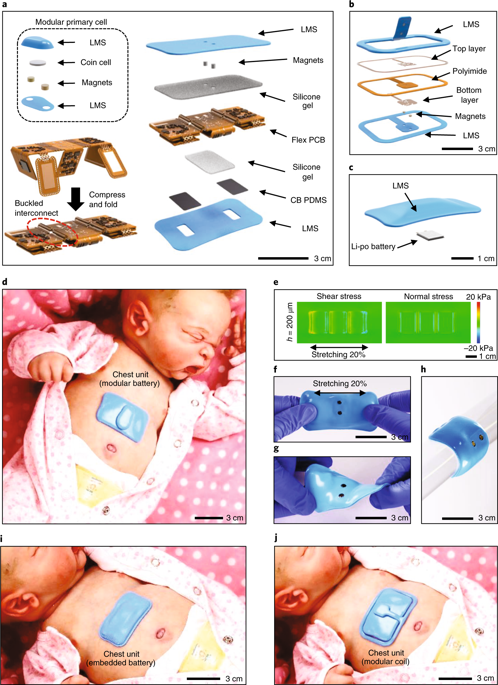Nature Medicine ( IF 58.7 ) Pub Date : 2020-03-11 , DOI: 10.1038/s41591-020-0792-9 Ha Uk Chung 1, 2, 3 , Alina Y Rwei 1, 3 , Aurélie Hourlier-Fargette 1, 3 , Shuai Xu 1, 3, 4 , KunHyuck Lee 1, 3, 5 , Emma C Dunne 6 , Zhaoqian Xie 7 , Claire Liu 1, 3, 8 , Andrea Carlini 1, 3, 5 , Dong Hyun Kim 3, 9 , Dennis Ryu 3, 10 , Elena Kulikova 10 , Jingyue Cao 10 , Ian C Odland 3 , Kelsey B Fields 3, 5 , Brad Hopkins 6 , Anthony Banks 1, 3 , Christopher Ogle 3 , Dominic Grande 3 , Jun Bin Park 3 , Jongwon Kim 11, 12 , Masahiro Irie 1, 2, 3 , Hokyung Jang 3, 13 , JooHee Lee 10 , Yerim Park 14 , Jungwoo Kim 14 , Han Heul Jo 14 , Hyoungjo Hahm 9 , Raudel Avila 3, 5, 15, 16 , Yeshou Xu 3, 5, 15, 16, 17 , Myeong Namkoong 1, 8 , Jean Won Kwak 1, 3, 15 , Emily Suen 18 , Max A Paulus 19 , Robin J Kim 3 , Blake V Parsons 3 , Kelia A Human 8 , Seung Sik Kim 9 , Manish Patel 1, 3, 5, 10, 20 , William Reuther 21 , Hyun Soo Kim 9, 13 , Sung Hoon Lee 9 , John D Leedle 10 , Yeojeong Yun 13 , Sarah Rigali 10 , Taeyoung Son 13 , Inhwa Jung 12 , Hany Arafa 1, 3, 8 , Vinaya R Soundararajan 4 , Ayelet Ollech 4 , Avani Shukla 22 , Allison Bradley 6 , Molly Schau 23 , Casey M Rand 6, 24 , Lauren E Marsillio 22, 25 , Zena L Harris 22, 25 , Yonggang Huang 3, 5, 15, 16 , Aaron Hamvas 22, 23, 24 , Amy S Paller 3, 5, 22 , Debra E Weese-Mayer 6, 22, 24 , Jong Yoon Lee 1, 3, 9, 10 , John A Rogers 1, 3, 5, 8, 13, 15, 26, 27

|
Standard clinical care in neonatal and pediatric intensive-care units (NICUs and PICUs, respectively) involves continuous monitoring of vital signs with hard-wired devices that adhere to the skin and, in certain instances, can involve catheter-based pressure sensors inserted into the arteries. These systems entail risks of causing iatrogenic skin injuries, complicating clinical care and impeding skin-to-skin contact between parent and child. Here we present a wireless, non-invasive technology that not only offers measurement equivalency to existing clinical standards for heart rate, respiration rate, temperature and blood oxygenation, but also provides a range of important additional features, as supported by data from pilot clinical studies in both the NICU and PICU. These new modalities include tracking movements and body orientation, quantifying the physiological benefits of skin-to-skin care, capturing acoustic signatures of cardiac activity, recording vocal biomarkers associated with tonality and temporal characteristics of crying and monitoring a reliable surrogate for systolic blood pressure. These platforms have the potential to substantially enhance the quality of neonatal and pediatric critical care.
中文翻译:

用于新生儿和儿科重症监护室高级无线生理监测的皮肤界面生物传感器
新生儿和儿科重症监护病房(分别为 NICU 和 PICU)的标准临床护理包括使用附着在皮肤上的硬连线设备持续监测生命体征,在某些情况下,可能涉及插入导管的基于导管的压力传感器。动脉。这些系统存在引起医源性皮肤损伤、临床护理复杂化和阻碍父母与孩子之间皮肤接触的风险。在这里,我们提出了一种无线、非侵入性技术,它不仅提供与现有临床标准的心率、呼吸频率、温度和血氧合测量等效性,而且还提供了一系列重要的附加功能,由试点临床研究的数据支持在 NICU 和 PICU 中。这些新模式包括跟踪运动和身体方向,量化皮肤对皮肤护理的生理益处,捕捉心脏活动的声学特征,记录与哭声的音调和时间特征相关的声音生物标志物,并监测收缩压的可靠替代物。这些平台有可能大大提高新生儿和儿科重症监护的质量。











































 京公网安备 11010802027423号
京公网安备 11010802027423号